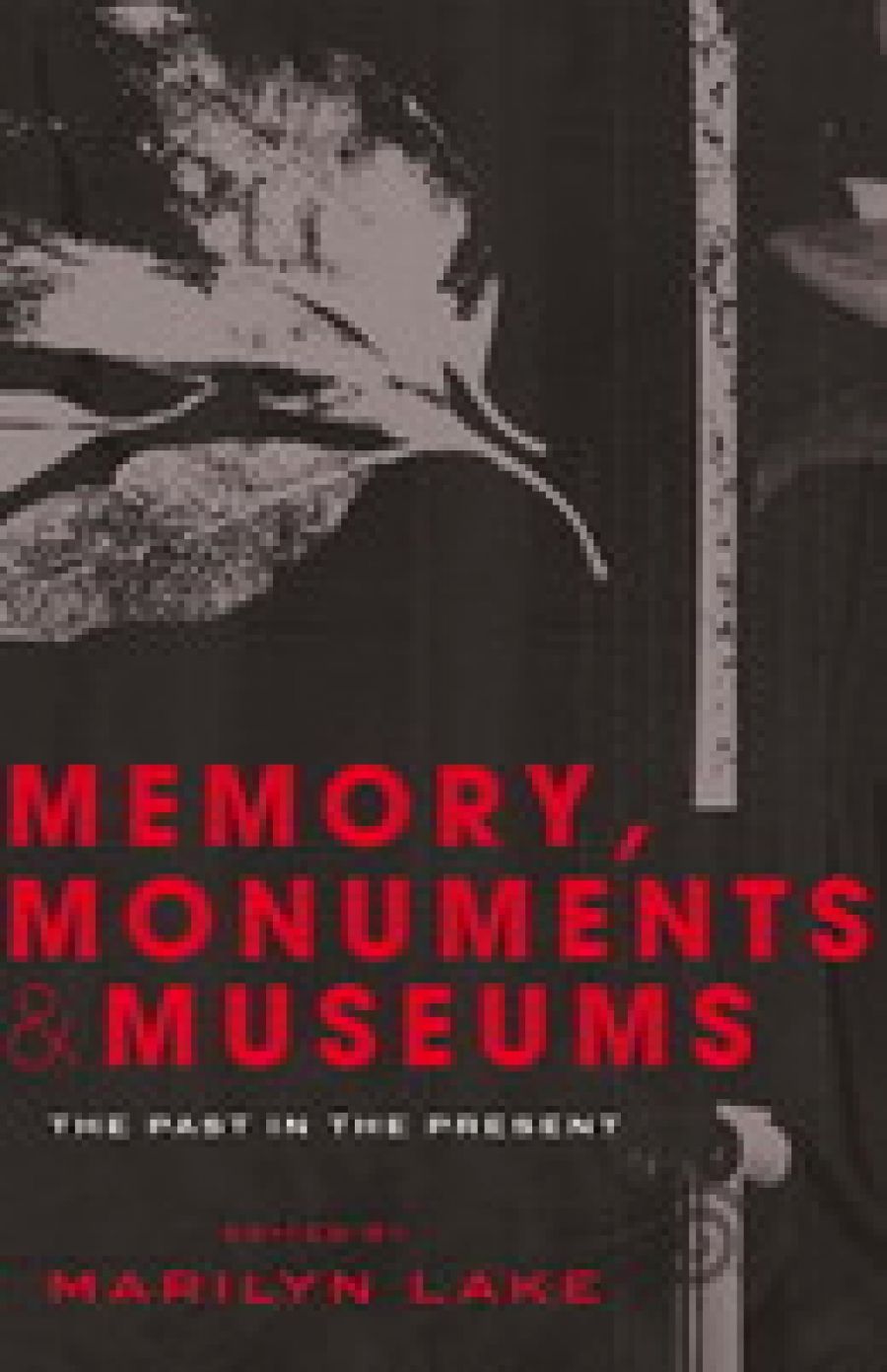
- Free Article: No
- Review Article: Yes
- Article Title: The Wisdom Room
- Online Only: No
- Custom Highlight Text:
This book consists of sixteen essays based on papers delivered at the symposium of the Australian Academy of the Humanities held in Hobart in 2004. The title of the book was the theme of the symposium. A conference must have a theme, of course, or no one would ever fund the participants, but individual speakers do not always address it, or they do so tangentially. We have all been at conferences where the relationship of the speaker’s paper to the theme is the same as that between the ugly sisters’ feet and Cinderella’s dancing slipper – a great deal of stretching and contorting to make the text fit the theme, and vice versa. This is why conference proceedings rarely make good books.
- Book 1 Title: Memory, Monuments And Museums
- Book 1 Subtitle: The past in the present
- Book 1 Biblio: MUP, $34.95 pb, 294 pp
The succeeding essays only fitfully address this theme; the book is really a collection of stand-alone essays, rather than a coordinated argument. There are nonetheless some fine contributions. Peter Conrad’s elegant and literate ‘A History of Memory’ takes us from Mnemosyne, the mother of the muses in Greek mythology, through the classical concept of a disciplined memory, to a latter-day more uncontrolled memory revealing psychological truth. Michael Bennett’s ‘The Heritage of “Old England”’ argues that this concept was invented by the early settlers to cope with their sense of exile. Those back in Britain actually had little appreciation or knowledge of this heritage. Further, for the colonists, paradoxically, England was more ‘a source of novelty, whether of ideas, technology or fashion’. Bill Gammage’s important paper deals with the way the Tasmanian Aborigines transformed their landscape by fire in planned cycles, each cycle lasting hundreds of years. Katie Holmes looks at how the making of gardens both soothed the colonists’ nostalgia and established their sense of place in the new land.
A conference would not be complete, though, without the pretentious and the silly. Ien Ang’s paper, ‘The Art Museum as Monument: Cultural Change Contained’, draws portentous conclusions from very little. The Art Gallery of New South Wales decided that for its 2001 exhibition Buddha: Radiant Awakening it would try to attract the Asian community. It would do this by making the exhibition a cultural experience, there being no tradition of the purely art museum in Asia. So various Buddhist communities participated in a number of activities during the exhibition: tea ceremony, chanting, meditation, calligraphy. There was also a Wisdom Room. Ang says this was a major departure, as European art is not presented in this way. Perhaps not to the same extent, but most galleries have cultural programmes associated with major exhibitions. ‘[W]hereas European art is allowed to maintain its elevated status as autonomous high art, Asian and Aboriginal art have somehow to be brought down to the level of popular culture.’ Picasso on a tea towel, I suppose, is high art. The ‘cultural change contained’ refers to the fact that nonetheless the criterion for choosing individual exhibits was their quality as art per se:
What Buddha: Radiant Awakening … has opened up is the possibility of a more pluralistic attitude towards art, a recognition of its polysemy – the different kinds of meaning and value that can be attached to it.
Just as you say, Professor Ang.
Marilyn Lake’s thesis is that the plethora of war memorials following World War I was to compensate for the fact that Federation had not delivered full independence. There are no statues of the Founding Fathers, you see. If the author had provided even an adumbration of an argument I may not have called this silly, just misguided. According to Professor Lake, Deakin discovered after 1901 that he was still a colonial. Lake recounts how the British were furious with Deakin because he invited Teddy Roosevelt to Australia, and also the American Naval Fleet without consulting them. But the point is that he did invite them, and there was nothing the British could do about it. Even Lake admits: ‘Deakin never wasted an opportunity to remind the British that the Australians enjoyed the manly prerogative of self-government.’ Lake laments the fact that Australia did not become a republic in 1901, and ascribes this view to Australians of the time. The 1999 republic referendum result was the most recent confirmation that Australians do not see it this way.
The final essay, by Henry Reynolds, deals with the controversy surrounding the commemoration of the two-hundredth anniversary of white settlement in Tasmania. The first settlement was at Risdon in August 1803. No dispute about that. However, the Tasmanian Government decided that the commemoration would be in 2004. There was no official explanation. The speculation was that Risdon was being erased because it had been the scene of the first fatal conflict between Aborigines and settlers. ‘What I tell you three times is true,’ the Bellman in Lewis Carroll’s The Hunting of the Snark said, but Premier Jim Bacon only had to say it once. Ironically, the Aboriginal deaths had occurred in May 1804. You can argue that there should have been no commemoration or you can debate the form of that commemoration, but you cannot change the date. Except in Tasmania. And what did our Academicians, who had been planning their symposium for 2003, do? They tugged their forelocks and moved it to 2004. Deconstruct that.


Comments powered by CComment